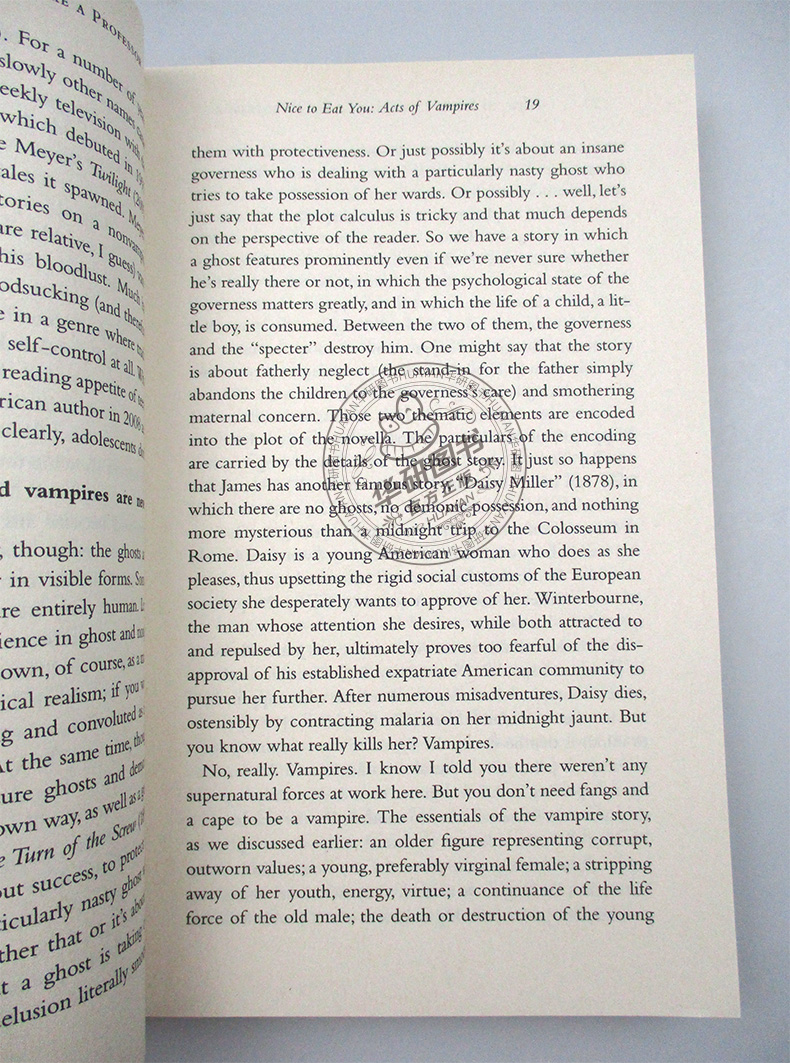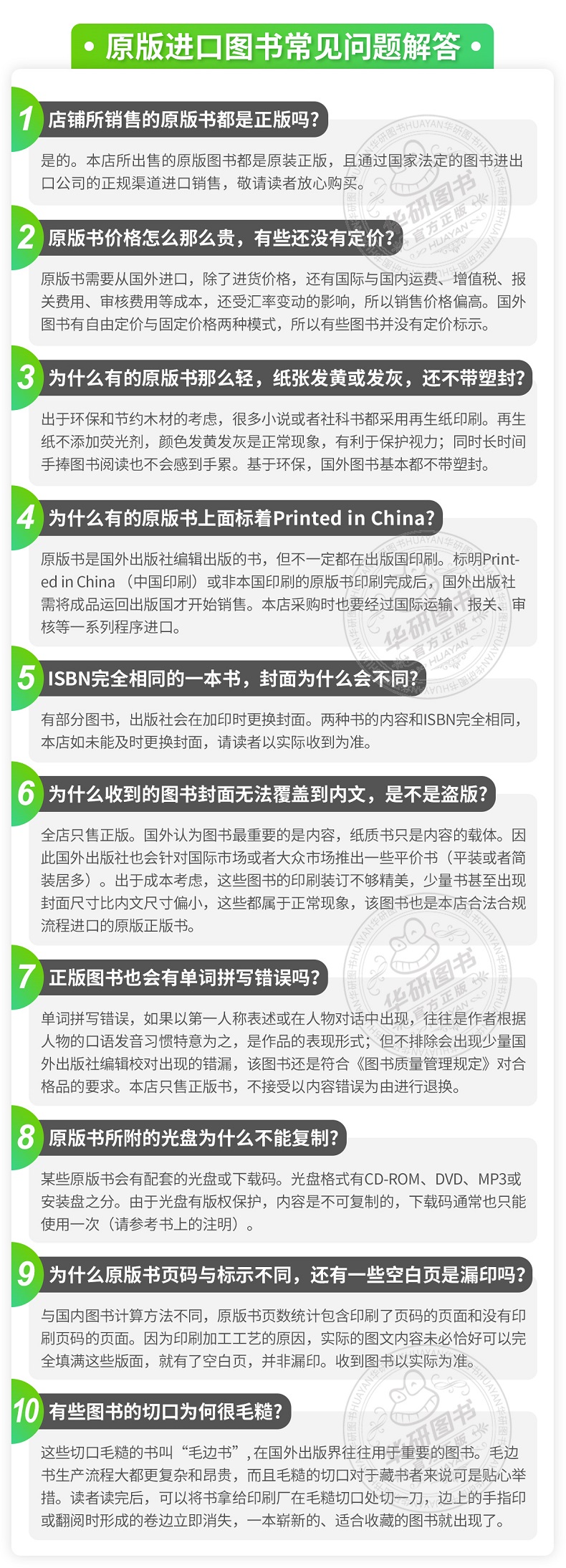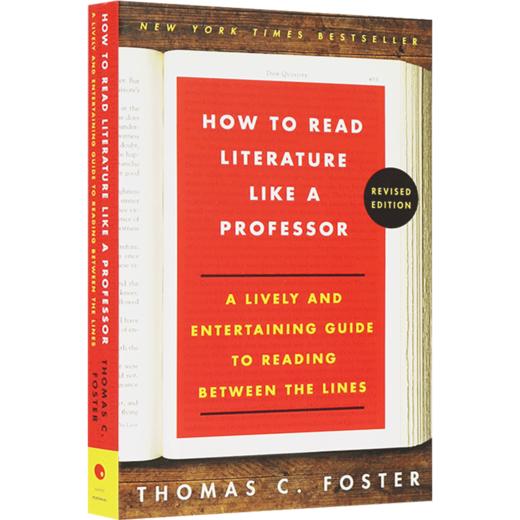Collins柯林斯 正版 如何阅读一本文学书 英文原版 How to Read Literature Like a Professor 美国大学教材读物 英文版进口英语书籍
| 运费: | ¥ 0.00-999.00 |
| 库存: | 97 件 |
商品详情




书名:How to Read Literature Like a Professor 如何阅读文学书难度:Lexile蓝思阅读指数1150
作者:Thomas C. Foster
出版社名称:Harper Perennial
出版时间:2014
语种:英文
ISBN:9780062301673
商品尺寸:13.5 x 2.0 x 20.3 cm
包装:平装
页数:336 (以实物为准)

How to Read Literature Like a Professor《如何阅读一本文学书》是《如何阅读一本小说》的姊妹篇,是美国广受欢迎的文学教授托马斯•福斯特的作品。福斯特教授已有二十多年教授文学阅读的经验,他在这本书里以通俗易懂、非学术化的文笔,探讨那些被我们忽略却又充满趣味性的文学问题:一顿美餐有什么深意?雨雪风霜里隐含着哪种感情?什么画面中隐藏着性事,而赤裸的性描写又是想要表现什么?本书例证丰富,援引各种体裁,包括长篇小说、短篇小说、戏剧、诗歌、电影、歌词、动画等300部作品赏析。《如何阅读一本文学书》不是教科书,而是引人入胜的入门指南。在与本书相遇之前,你并不知道你会爱上文学。 “Dante had his virgil; for everyone else, there is Thomas Foster.” — Nicholas A. Basbanes A thoroughly revised and updated edition of Thomas C. Foster’s classic guide — a lively and entertaining introduction to literature and literary basics, including symbols, themes and contexts, that shows you how to make your everyday reading experience more rewarding and enjoyable. While many books can be enjoyed for their basic stories, there are often deeper literary meanings interwoven in these texts. How to Read Literature Like a Professor helps us to discover those hidden truths by looking at literature with the eyes — and the literary codes — of the ultimate professional reader, the college professor. What does it mean when a literary hero is traveling along a dusty road? When he hands a drink to his companion? When he’s drenched in a sudden rain shower? Ranging from major themes to literary models, narrative devices and form, Thomas C. Foster provides us with a broad overview of literature — a world where a road leads to a quest, a shared meal may signify a communion, and rain, whether cleansing or destructive, is never just a shower-and shows us how to make our reading experience more enriching, satisfying, and fun. This revised edition includes new chapters, a new preface and epilogue, and incorporates updated teaching points that Foster has developed over the past decade.

全美广受欢迎的文学公开课教授托马斯·福斯特,继《如何阅读一本小说》之后,针对小说、电影、戏剧、诗歌等各类文学作品,进行了一次新的梳理,告诉我们迈向文学探索之路,找到“蘑菇”,是多么容易且富有乐趣。旅行的目的绝不是表面看起来那么单纯,吃一顿饭也不只是为了填饱肚子,雨雪天也不是天气预报的问题。这些文学中隐而不说的含义,借助作者阅读文学的3件法宝、20多个小诀窍、300部作品的赏析,丰富你的阅读体验。 How to Read Literature Like a ProfessorA Broad Overview of Literature* A lively and entertaining guide to making your reading experience more rewarding and Fun * Focuses on literary basics: major themes and motifs (seasons, quests, food, politics, geography, weather, vampires, violence, illness, and many more); literary models (Shakespeare’s plays, Greek mythology, fairy tales, the Bible); and narrative devices (form, irony, plot, andsymbol, among others). * Draws on a huge variety of examples from all genres novels, short stories, plays, poems, movies, song lyrics, and cartoons. * Encourages readers to test their knowledge on the short story “The Garden Party” by Katherine Mansfield, offering comments and ideas along the way. Based on More than Thirty Years of Experience and Expertise* Thomas C. Foster has been teaching students how to read literature for more than thirty years. *How to Read Literature Like a Professorapproaches the often intimidating domain of literature in accessible and nonacademic prose. It is not a textbook but an engaging companion for readers to discover the possibilities of modern and classic literature. The Perfect Resource for Reading Groups* With its informal style and easy approach to literature,How to Read Literature Like a Professor is a useful and practical tool for reading groups and book clubs. Suggests Further Reading Material * Includes a comprehensive list of novels, poems, and plays that readers may find enjoyable and challenging. * Offers suggestions for secondary sources on reading, interpretation, and criticism.

托马斯·福斯特(Thomas Foster):美国密歇根大学教授,专长20世纪英国、爱尔兰及美国文学,教授经典文学和当代文学课程,同时教授创意写作。著有多部学术研究著作及畅销文学阅读指南书。 Thomas C. Foster is a professor of English at the University of Michigan-Flint, where he teaches classic and contemporary fiction, drama, and poetry, as well as creative writing and composition. In addition toHow to Read Novels Like a Professor, he is the author ofHow to Read Literature Like a Professor and several books on twentieth-century British and Irish fiction and poetry. He lives in East Lansing, Michigan.

PREFACE INTRODUCTION How’d He Do That? 1. Every Trip Is a Quest (Except When It’s Not) 2. Nice to Eat with You: Acts of Communion 3. Nice to Eat You: Acts of Vampires 4. Now, Where Have I Seen Her Before? 5. When in Doubt, It’s from Shakespeare… 6. … Or the Bible 7. Hanseldee and Greteldum 8. It’s Greek to Me 9. It’s More Than Just Rain or Snow 10. Never Stand Next to the Hero INTERLUDE Does He Mean That? 11. … More Than It’s Gonna Hurt You: Concerning Violence 12. Is That a Symbol? 13. It’s All Political 14. Yes, She’s a Christ Figure, Too 15. Flights of Fancy 16. It’s All About Sex… 17. … Except Sex 18. If She Comes Up, It’s Baptism 19. Geography Matters… 20. … So Does Season INTERLUDE One Story 21. Marked for Greatness 22. He’s Blind for a Reason, You Know 23. It’s Never just Heart Disease… And Rarely Just Illness 24. Don’t Read with Your Eyes 25. It’s My Symbol and I’ll Cry If I Want To 26. Is He Serious? And Other Ironies 27. A Test Case POSTLUDE: Who’s in Charge Here? ENVOI APPENDIX Reading List ACKNOWLEDGMENTS INDEX 前言 序 文学教授是怎么读文学的 1每一次旅程都是追寻(当然凡事总有例外) 2你是我的座上客:关于圣餐礼的故事 3你是我的口中食:关于吸血鬼的故事 4若格局方正,便是十四行诗 5我在哪儿见过她来着? 6要是拿不准,可能是出自莎士比亚 7还是拿不准?那可能是出自圣经 8迷失在森林中的孩子—也可能来自童话 9文学很希腊 10雨雪风霜总关情 插曲 作者真是这意思吗? 11暴力,不只会伤害你 12这是象征吗? 13一切皆政治 14不错,他也是基督的化身 15乘着想象的翅膀 16一切皆为性 17谈性非为性 18如果没淹死,就是成功受洗 19地理很关键 20季节也很重要 21长相特殊者,往往与众不同 22失明总是有原因的 23心脏病不只是心脏的病 24作家们偏爱哪些疾病 25不要只用自己的眼睛读 26“他是认真的吗?”打碎期待的反讽 27测验 终曲谁掌控这里? 跋 附录 阅读书目 致谢 索引

Okay, so here’s the deal: let’s say, purely hypothetically, you’re reading a book about an average sixteen-year-old kid in the summer of 1968. The kid — let’s call him Kip — who hopes his acne clears up before he gets drafted, is on his way to the A&P. His bike is a one-speed with a coaster brake and therefore deeply humiliating, and riding it to run an errand for his mother makes it even worse. Along the way he has a couple of disturbing experiences, including a minorly unpleasant encounter with a German shepherd, topped off in the supermarket parking lot where he sees the girl of his dreams, Karen, laughing and horsing around in Tony Vauxhall’s brand-new Barracuda. Now Kip hates Tony already because he has a name like Vauxhall and not like Smith, which Kip thinks is pretty lame as a name to follow Kip, and because the ’Cuda is bright green and goes approximately the speed of light, and also because Tony has never had to work a day in his life. So Karen, who is laughing and having a great time, turns and sees Kip, who has recently asked her out, and she keeps laughing. (She could stop laughing and it wouldn’t matter to us, since we’re considering this structurally. In the story we’re inventing here, though, she keeps laughing.) Kip goes on into the store to buy the loaf of Wonder Bread that his mother told him to pick up, and as he reaches for the bread, he decides right then and there to lie about his age to the Marine recruiter even though it means going to Vietnam, because nothing will ever happen for him in this one-horse burg where the only thing that matters is how much money your old man has. Either that or Kip has a vision of St. Abillard (any saint will do, but our imaginary author picked a comparatively obscure one), whose face appears on one of the red, yellow, or blue balloons. For our purposes, the nature of the decision doesn’t matter any more than whether Karen keeps laughing or which color balloon manifests the saint. What just happened here? If you were an English professor, and not even a particularly weird English professor, you’d know that you’d just watched a knight have a not very suitable encounter with his nemesis. In other words, a quest just happened. But it just looked like a trip to the store for some white bread. True. But consider the quest. Of what does it consist? A knight, a dangerous road, a Holy Grail (whatever one of those may be), at least one dragon, one evil knight, one princess. Sound about right? That’s a list I can live with: a knight (named Kip), a dangerous road (nasty German shepherds), a Holy Grail (one form of which is a loaf of Wonder Bread), at least one dragon (trust me, a ’68 ’Cuda could definitely breathe fire), one evil knight (Tony), one princess (who can either keep laughing or stop). Seems like a bit of a stretch.On the surface, sure. But let’s think structurally. The quest consists of five things: (a) a quester, (b) a place to go, (c) a stated reason to go there, (d) challenges and trials en route, and (e) a real reason to go there. Item (a) is easy; a quester is just a person who goes on a quest, whether or not he knows it’s a quest. In fact, usually he doesn’t know. Items (b) and (c) should be considered together: someone tells our protagonist, our hero, who need not look very heroic, to go somewhere and do something. Go in search of the Holy Grail. Go to the store for bread. Go to Vegas and whack a guy. Tasks of varying nobility, to be sure, but structurally all the same. Go there, do that. Note that I said the stated reason for the quest. That’s because of item (e).

1234567
- 华研外语批发分销官方旗舰店 (微信公众号认证)
- 本店是“华研外语”品牌商自营店,全国所有“华研外语”、“华研教育”品牌图书都是我司出版发行的,本店为华研官方源头出货,所有图书均为正规正版,拥有实惠与正版的保障!!!
- 扫描二维码,访问我们的微信店铺
- 随时随地的购物、客服咨询、查询订单和物流...










